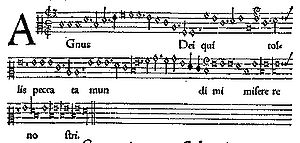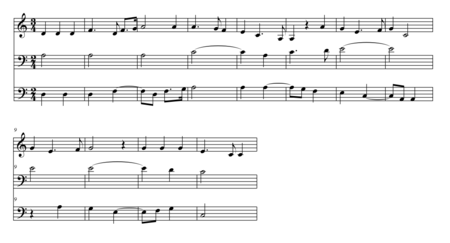
Missa L'homme armé super voces musicales
Encyclopedia

Ordinary of the Mass
The ordinary, in Roman Catholic and other Western Christian liturgies, refers to the part of the Eucharist or of the canonical hours that is reasonably constant without regard to the date on which the service is performed...
, by Josquin des Prez
Josquin Des Prez
Josquin des Prez [Josquin Lebloitte dit Desprez] , often referred to simply as Josquin, was a Franco-Flemish composer of the Renaissance...
, which use the famous L'homme armé
L'homme armé
L'homme armé was a French secular song from the time of the Renaissance. It was the most popular tune used for musical settings of the Ordinary of the Mass: over 40 separate compositions entitled Missa L'homme armé survive from the period....
tune as their cantus firmus
Cantus firmus
In music, a cantus firmus is a pre-existing melody forming the basis of a polyphonic composition.The plural of this Latin term is , though the corrupt form canti firmi is also attested...
source material; (for the other, presumed later, setting see Missa L'homme armé sexti toni
Missa L'homme armé sexti toni
Missa L'homme armé sexti toni is probably the later of two L'homme arme masses by Josquin des Prez - 'sexti toni' refers to the use of the 'sixth mode'. The theme is shared between all voices rather than being confined to the tenor, as in Josquin's earlier L'homme armé mass...
). The setting is for four voices. It was the most famous mass Josquin composed, surviving in numerous manuscripts and print editions. The earliest printed collection of music devoted to a single composer, the Misse Josquin published by Ottaviano Petrucci
Ottaviano Petrucci
Ottaviano Petrucci was an Italian printer. His Harmonice Musices Odhecaton, a collection of chansons printed in 1501, is commonly misidentified as the first book of sheet music printed from movable type. Actually that distinction belongs to the Roman printer Ulrich Han's Missale Romanum of 1476...
in 1502, begins with this famous work.
Background
Dating of the mass has been controversial, with some scholars proposing a mid-career date, for example during Josquin's Roman period (roughly 1489 to 1495), and other scholars, such as Gustave ReeseGustave Reese
Gustave Reese was an American musicologist and teacher. Reese is known mainly for his work on medieval and Renaissance music, particularly with his two publications Music in the Middle Ages and Music in the Renaissance ; these two books remain the standard reference works for these two eras,...
, arguing for an earlier date, claiming that the contrapuntal complexity the mass shows is more typical of Josquin's early style, and that he simplified his method as he aged. The earliest source containing the mass is the Vatican manuscript CS 197 (c. 1492–1495) In his 1547 Dodekachordon, Heinrich Glarean
Heinrich Glarean
Heinrich Glarean was a Swiss music theorist, poet and humanist. He was born in Mollis and died in Freiburg....
wrote that Josquin "composed the two L'homme armé masses to show off his skill."
Music
While usually classified as a cantus firmus mass, the use of snatches of the tune in other voices foreshadows the paraphraseParaphrase mass
A paraphrase mass is a musical setting of the Ordinary of the Mass, using as its basis an elaborated version of a cantus firmus, typically chosen from plainsong or some other sacred source...
technique which Josquin was to use extensively later in works such as the Missa Pange lingua
Missa Pange lingua
The Missa Pange lingua is a musical setting of the Ordinary of the Mass by Franco-Flemish composer Josquin des Prez, probably dating from around 1515, near the end of his life...
, and which was to become one of the standard methods of writing cyclic mass
Cyclic mass
In Renaissance music, the cyclic mass was a setting of the Ordinary of the Roman Catholic Mass, in which each of the movements – Kyrie, Gloria, Credo, Sanctus, and Agnus Dei – shared a common musical theme, commonly a cantus firmus, thus making it a unified whole...
es in the 16th century.
Like most settings of the mass, it is in five sections:
- KyrieKyrieKyrie, a transliteration of Greek κύριε , vocative case of κύριος , meaning "Lord", is the common name of an important prayer of Christian liturgy, which is also called the Kýrie, eléison ....
- GloriaGloria in Excelsis Deo"Gloria in excelsis Deo" is the title and beginning of a hymn known also as the Greater Doxology and the Angelic Hymn. The name is often abbreviated to Gloria in Excelsis or simply Gloria.It is an example of the psalmi idiotici "Gloria in excelsis Deo" (Latin for "Glory to God in the highest")...
- CredoCredoA credo |Latin]] for "I Believe") is a statement of belief, commonly used for religious belief, such as the Apostles' Creed. The term especially refers to the use of the Nicene-Constantinopolitan Creed in the Mass, either as text, Gregorian chant, or other musical settings of the...
- SanctusSanctusThe Sanctus is a hymn from Christian liturgy, forming part of the Order of Mass. In Western Christianity, the Sanctus is sung as the final words of the Preface of the Eucharistic Prayer, the prayer of consecration of the bread and wine...
and Benedictus - Agnus Dei (in three sections: I, II, III)

Missa prolationum
The Missa prolationum is a musical setting of the Ordinary of the Mass, by Johannes Ockeghem, dating from the second half of the 15th century...
, which contains nothing but mensuration canons. In a mensuration
Mensural notation
Mensural notation is the musical notation system which was used in European music from the later part of the 13th century until about 1600."Mensural" refers to the ability of this system to notate complex rhythms with great exactness and flexibility...
canon, each voice sings the same notes, but the length of time each note is sung differs. The opening Kyrie of Josquin's mass contains consecutive mensuration canons based on each phrase of the L'homme armé tune, with the tenor leading each and the other voices entering in turn. The second of the three of Agnus Dei sections is another well-known mensuration canon (see example); this particular canon was famous in the sixteenth century, and often mentioned in theoretical treatises.
The last of the three repetitions of the Agnus Dei, the section that closes the mass, is the longest, and is accompanied by a direction in the score: "Clama ne cesses" ("cry without ceasing", from Isaiah 58:1), which in this context means to sing the tune without any of the rests. The cantus firmus is pitched on A, the highest note of the hexachord, and is in double augmentation. The length, and the sustained notes of the cantus firmus, refer both to the "cry for mercy" aspect of the Agnus Dei text, which cries to the Lamb of God to take away the sins of the world, and to the trumpet motif and text "On a fait partout crier" from the original L'homme armé tune, calling the listeners to arms.
In addition to the canonic complexities, Josquin adds variety by beginning the L'homme armé tune on a successively higher note in each section (and also in the third Agnus Dei), one for each of the six notes in the natural hexachord
Hexachord
In music, a hexachord is a collection of six pitch classes including six-note segments of a scale or tone row. The term was adopted in the Middle Ages and adapted in the twentieth-century in Milton Babbitt's serial theory.-Middle Ages:...
(thus the title, "voces musicales", or solmization
Solmization
Solmization is a system of attributing a distinct syllable to each note in a musical scale. Various forms of solmization are in use and have been used throughout the world.In Europe and North America, solfège is the convention used most often...
syllables, ut, re, mi, fa, sol, la). The overall modality is Dorian, and all of the movements end on D.

